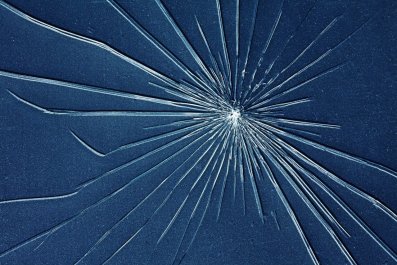It's almost unfathomable: A naked man - pale and wiry, his head shaved - sits silently with his scrotum nailed to the cobblestones in Moscow's Red Square. With his legs spread, knees cocked and arms stretched behind him, he hangs his head and stares between his legs as if giving birth to his pain. And his protest. Russian conceptual artist Pyotr Pavlensky's act, Fixation, which he performed last week in front of Lenin's tomb, protested Russia's decline into what he calls a police state.
"The performance can be seen as a metaphor for the apathy, political indifference, and fatalism of contemporary Russian society," Pavlensky, 29, said in a statement. "As the government turns the country into one big prison, stealing from the people and using the money to grow and enrich the apparatus and other repressive structures, society is allowing this, and [is] forgetting its numerical advantage, [and] is bringing the triumph of the police state closer by its inaction."
Pavlensky is no stranger to self-harm art. In July 2012, he sewed his mouth shut to protest the arrest of Russian punk band Pussy Riot. He called the performance Stitch. Last May, in his next performance, Carcass, he wrapped his naked body in barbed wire and lay in the fetal position outside of the legislative assembly of St. Petersburg. In Fixation, which Pavlensky timed to coincide with Russian Police Day, it took him only one minute to disrobe and get into position. Police swarmed immediately. Half an hour later, an emergency crew used a claw hammer to dislodge the large nail from the stones, then took the artist to the hospital, where he received basic medical care. He was arrested and released the following day, and now faces charges of hooliganism and could face up to five years in prison.
Pavlensky isn't the first artist to hammer a nail through his scrotum. His act has roots in a tradition of corporeal performance art handed down by a pioneering group of artists who transformed their bodies into canvases and materials - they literally beat, sewed, nailed, stapled, and shot themselves for art - pushing the boundaries of, well, pretty much everything.
In 1989, performance artist Bob Flanagan pushed his penis into his scrotum, sewed up his scrotum with a needle and thread and then nailed some of the remaining skin to a wood block - all the while standing naked before an audience, cracking jokes as the song "If I Had a Hammer" played in the background. The performance, called Nailed, wasn't a political protest. Flanagan's art was all about masochistic pleasure and healing, and grew out of his desire to make sense of his lifelong struggle with cystic fibrosis, a painful, incurable illness that he lived with until his death in 1996, at the age of 43. For Flanagan, making the audience squirm was secondary. His horrific acts - including adorning his scrotum with needles and putting his penis into a tight harness - explored the pleasure of pain, challenged conventional sexuality and pushed the limits of love, life, and the body. (The documentary Sick: The Life & Death of Bob Flanagan, Supermasochist, which film critic Roger Ebert called "one of the most agonizing films I have ever seen," tells the story of his life.)
"The idea that pain takes you to another place - a lot of [performance] artists talk about that. It changes you. It's a spiritual thing. It changes your consciousness," says Cynthia Carr, who has written extensively on avant-garde and performance art. "Some spectators find these things really cathartic and others find them really disturbing. For some, it's very moving."
"Although his choice of flesh mutilation has antecedents in performance art history," says Meiling Cheng, associate professor of dramatic arts and English at the USC School of Dramatic Arts and an expert on performance art, "the fact that he chose to do it publicly, on Red Square, expressed his politics, articulating his purpose of bringing Russia's current political state to the attention of the international media."
Indeed, Pavlensky's performance was made for the 21st century, an act so unimaginable that it was bound to be shared online - so shocking that we were all meant to read about it. And watch it. And then share it some more.

The concept of performance art came about by 1970. Artists abandoned the creation of objects as art in favor of art through performance, and their extreme, often outrageous acts challenged the status quo. It was all very êpater la bourgeoisie - an attempt to shock and amaze the refined middle class, a tradition that goes back to the Decadent movement in literature of the late 19th century, in which French writers, philosophers and artists explored taboo topics like death and sex.
In 1971, in what became one of the most arresting moments of the burgeoning performance art movement, Chris Burden had an assistant shoot him in the left arm with a .22 rifle from 15 feet away. Three years later, Burden lay on top of a Volkswagen Beetle and had his hands nailed to the roof. He also crawled half-naked across broken glass, touched live electrical cables to his chest and experimented with drowning. His extreme performances, which explored personal danger as art, unfolded in more private venues, in front of smaller audiences, and spread by word of mouth and written or photographic documentation. (A retrospective of his work is now on display at the New Museum in New York City.)
Self-harm and extreme performance art continued throughout the 1970s and 1980s. Marina Abramović cut her fingers with knives, induced seizures and memory lapse, and stood silently as strangers jabbed thorns into her abdomen and held a gun to her head. Gina Pane turned self-wounding into art. In 1994, artist Ron Athey stuck hypodermic needles into his arm and acupuncture needles into his head, then cut another performer on the back with a scalpel, blotted the blood with paper towels and hung them from a clothesline that stretched out above the audience. (The performance ignited a controversy over the National Endowment for the Arts because Athey, who was HIV-positive, had indirectly received $150 in NEA funding. He quickly became the poster example for NEA opponents.)
These artists operated in a world in which pain, danger, and pleasure collided to make the viewer feel something - discomfort, disgust, desire, empathy, shock. And while they all explore the limits of their bodies and minds, they were motivated by different intentions.
"For a lot of artists, what they're doing comes from a very personal place," Carr explains. "What [Athey] is doing is pretty edgy, but it's not being done as a political protest."
Athey's work explored religious extremism (he was raised in a Pentecostal home and told he was born with "the calling"). Flanagan's art, on the other hand, was a direct response to a life of illness and pain. In his Red Square demonstration, Pavlensky turns body manipulation into political protest.
To the question, "Is nailing your scrotum to the ground really art?" Carr says, "It is art if Pavlensky says it is. It creates a symbol for me to put in my mind, and that's what artists do."
But will one man's decision to publicly nail his scrotum to the ground change anything in Russia?
"When we see something that's so shocking, suddenly we're brought into awareness: What's happening in Russia? The political repression? What's going on with the people's frustration? Those are the messages he tries to convey. And there, his intention has already been fulfilled," Cheng says.

As performance artist Oleg Kulik, who frequently took on the identity of a dog and once put his head into a cow's vagina, told the Calvert Journal, "Call [Pavlensky] whatever you like, just don't call him insane. The people who call him that [are] the insane ones. You might even say he is the only sane person in Russia, because there is no other way of reacting to the current situation, after 25 years of 'liberation' from red terror."
"Nailing your scrotum to the ground is a bit extreme, not to be repeated by many people," Carr points out. "It's hard to know where to go from that."
With a rich history of bloody, torturous performance art at his fingertips, it's a safe bet that Pavlensky will come up with something.

























